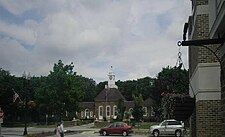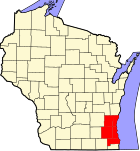Greendale, Wisconsin: Difference between revisions
m copyedit, refine cat, and AWB general fixes using AWB |
No edit summary |
||
| Line 80: | Line 80: | ||
|footnotes = |
|footnotes = |
||
}} |
}} |
||
'''Greendale''' is a village in [[Milwaukee County, Wisconsin|Milwaukee County]], [[Wisconsin]], [[United States]]. The population was 14,046 at the [[2010 United States Census|2010 census]] |
'''Greendale''' is a village in, cake,[[Milwaukee County, Wisconsin|Milwaukee County]], [[Wisconsin]], [[United States]]. The population was 14,046 at the [[2010 United States Census|2010 census]] |
||
==History== |
==History== |
||
Revision as of 20:45, 12 December 2013
Greendale, Wisconsin | |
|---|---|
 Greendale Village Hall | |
 Location of Greendale, Wisconsin | |
| Country | United States |
| State | Wisconsin |
| County | Milwaukee |
| Area | |
• Total | 5.57 sq mi (14.43 km2) |
| • Land | 5.56 sq mi (14.40 km2) |
| • Water | 0.01 sq mi (0.03 km2) |
| Elevation | 738 ft (225 m) |
| Population | |
• Total | 14,046 |
• Estimate (2012[3]) | 14,325 |
| • Density | 2,526.3/sq mi (975.4/km2) |
| Time zone | UTC-6 (Central (CST)) |
| • Summer (DST) | UTC-5 (CDT) |
| Area code | 414 |
| FIPS code | 55-31125Template:GR |
| GNIS feature ID | 1565837Template:GR |
Greendale is a village in, cake,Milwaukee County, Wisconsin, United States. The population was 14,046 at the 2010 census
History
Greendale was settled in 1939 as a public cooperative community in the New Deal Era. Construction of the new town would create jobs and thus help stimulate the national economic recovery following the Great Depression.
Greendale, which provided good housing at reasonable rents for moderate income urban families, was one of three "greenbelt" towns planned beginning in 1935 under the direction of Rexford Guy Tugwell, head of the United States Resettlement Administration, under authority of the Emergency Relief Appropriation Act. The two other greenbelt towns are Greenbelt, Maryland (near Washington, D.C.) and Greenhills, Ohio (near Cincinnati). The greenbelt towns not only provided work and affordable housing, but also served as a laboratory for experiments in innovative urban planning. Greendale's plan was designed between 1936 and 1937 by a staff headed by Joseph Crane, Elbert Peets, Harry Bentley, and Walter C. Thomas for a site that had formerly consisted of 3,400 acres (14 km2) of farmland.
Construction began on Greendale in July 1936 by the U.S. Department of Agriculture, and, despite a movers strike, the first courageous families moved in on April 30, 1938. The original downtown included a Village Hall, several businesses, and 572 living units in 366 buildings, each with an average of 5,000 square feet (460 m2) of space for lawns and gardens. The village included a tavern, movie theater, volunteer fire station, newspaper office (The Greendale Review), schools, cooperative market and beautiful stone carvings by Alonzo Hauser. The Farm Security Administration originally appointed Mr. Hauser to create the carvings for the village. Henry A. Wallace, who was at the time was the United States Secretary of Agriculture, toured the village upon its completion.
All of the property was owned by the government and then rented to families, based on income, housing need and family size. Income requirements were specific: a minimum annual income of $1,200 and a maximum of $2,700. Some exceptions were made for those with special skills such as medical doctors and other professionals. To prevent too rapid expansion, all new development was tightly controlled by Greendale residents through various homeowners associations, as well as the green belt of parkways surrounding the village.
In 1950 the Public Housing Administration gave Greendale residents the right to purchase their homes from the government. The transfer of ownership from the government to the people was largely complete by 1952.[4][5]
Eleanor Roosevelt, wife of President Franklin D. Roosevelt, visited the village early in its history.[6]
It is listed on the National Register of Historic Places as the Greendale Historic District.[7]
-
Houses in Greendale
-
Original stone carving by Alonzo Hauser
-
The now gone Greendale Theater
Geography
Greendale is located at 42°56′15″N 87°59′49″W / 42.937615°N 87.996884°W (42.937615, -87.996884).Template:GR The Root River flows through the western part of the village.
According to the United States Census Bureau, the village has a total area of 5.57 square miles (14.43 km2), of which, 5.56 square miles (14.40 km2) of it is land and 0.01 square miles (0.03 km2) is water.[1]
Demographics
2010 census
As of the census[2] of 2010, there were 14,046 people, 6,075 households, and 4,016 families residing in the village. The population density was 2,526.3 inhabitants per square mile (975.4/km2). There were 6,294 housing units at an average density of 1,132.0 per square mile (437.1/km2). The racial makeup of the village was 92.8% White, 1.2% African American, 0.4% Native American, 3.1% Asian, 0.9% from other races, and 1.6% from two or more races. Hispanic or Latino of any race were 4.7% of the population.
There were 6,075 households of which 28.0% had children under the age of 18 living with them, 52.5% were married couples living together, 10.0% had a female householder with no husband present, 3.6% had a male householder with no wife present, and 33.9% were non-families. 30.1% of all households were made up of individuals and 17% had someone living alone who was 65 years of age or older. The average household size was 2.31 and the average family size was 2.87.
The median age in the village was 45.3 years. 22.1% of residents were under the age of 18; 5.6% were between the ages of 18 and 24; 21.7% were from 25 to 44; 28.2% were from 45 to 64; and 22.2% were 65 years of age or older. The gender makeup of the village was 46.6% male and 53.4% female.
2000 census
As of the 2000 census, there were 14,405 people, 6,011 households, and 4,207 families residing in the village. The population density was 2,571.8 people per square mile (993.2/km2). There were 6,165 housing units at an average density of 1,100.7 per square mile (425.1/km2). The racial makeup of the village was 96.18% White, 0.28% African American, 0.16% Native American, 2.05% Asian, 0.01% Pacific Islander, 0.56% from other races, and 0.75% from two or more races. Hispanic or Latino of any race were 2.36% of the population.
There were 6,011 households out of which 27.7% had children under the age of 18 living with them, 58.5% were married couples living together, 8.8% had a female householder with no husband present, and 30.0% were non-families. 26.9% of all households were made up of individuals and 13.4% had someone living alone who was 65 years of age or older. The average household size was 2.38 and the average family size was 2.88.
In the village the population was spread out with 22.4% under the age of 18, 6.0% from 18 to 24, 23.7% from 25 to 44, 27.9% from 45 to 64, and 20.1% who were 65 years of age or older. The median age was 44 years. For every 100 females there were 89.1 males. For every 100 females age 18 and over, there were 84.9 males.
The median income for a household in the village was $55,553, and the median income for a family was $65,071. Males had a median income of $47,534 versus $31,576 for females. The per capita income for the village was $28,363. About 3.0% of families and 3.9% of the population were below the poverty line, including 3.1% of those under age 18 and 2.2% of those age 65 or over.
Notable residents
- Noted nineteenth-century folklorist and linguist Jeremiah Curtin lived in what is now Greendale, but at the time was part of the rural Town of Greenfield. His boyhood home stands as a historic landmark.
- Emmy-nominated actress Jane Kaczmarek was born and raised in Greendale. She attended Greendale High School and still plays a major role in its theater department.
- Roy Reiman, founder of Reiman Publications. Reiman Publications is now owned by The Reader's Digest Association.
Historic places
Education
- Greendale High School was named by Newsweek as one of America’s Best High Schools according to its 2009 & 2010 rankings.[8][9] In 2007 the Greendale School District was ranked by Milwaukee Magazine as the top school system among the Milwaukee metropolitan area.[10]
- Martin Luther High School
References
- ^ a b "US Gazetteer files 2010". United States Census Bureau. Retrieved 2012-11-18.
- ^ a b "American FactFinder". United States Census Bureau. Retrieved 2012-11-18.
- ^ "Population Estimates". United States Census Bureau. Retrieved 2013-06-24.
- ^ http://www.wisconsinhistory.org/whi/feature/greendale/
- ^ http://www.wisconsinhistory.org/hp/register/viewSummary.asp?refnum=05000763
- ^ http://thegreendalehistoricalsociety.org/history_files/tag-eleanor-roosevelt.html
- ^ http://www.waymarking.com/waymarks/WM233P_Greendale_Historic_District
- ^ http://www.newsweek.com/id/201160 Retrieved 2009-10-29
- ^ http://www.newsweek.com/feature/2010/americas-best-high-schools/list.html
- ^ http://www.milwaukeemagazine.com/guides/default.asp?newmessageid=13643 Retrieved 2009-10-29
External links
- Village of Greendale
- Greendale School District
- Greendale Life News: Greendale News, Events & Businesses
- Greendale Originals: The History of Greendale from 1938 to the Present
- Greendale Public Library [1]
- Greendale Historical Society: The Official Website of the Greendale Historical Society
- Everything Greendale: everythinggreendale.com News, information and resources
- Greendale Park & Recreation [2]
- Greendale Entertainment Association
- Greendale Lions Club
- Reiman Publications
- Aerial photograph of city in 1936 and 2013.





